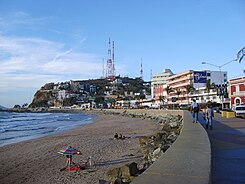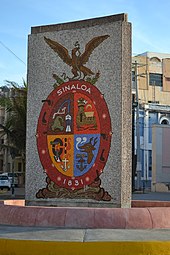Paseo Olas Altas
| Paseo Olas Altas | |
|---|---|
| Street in Mazatlán | |
| Beach and Paseo Olas Altas | |
| Basic data | |
| place | Mazatlan |
| District | Centro |
| Connecting roads | Covarrubias (beginning) and General Ángel Flores (end) as well as Paseo del Centenario (southern "continuation") and Paseo Claussen (northern "continuation") |
| Cross streets | Licenciado Miguel Alemán, Doctor Héctor González Guevara, Sixto Osuna, Constitución, Mariano Escobedo, Malpica, Olas |
| Places | La Gran Plaza |
| Buildings | Escuela Primaria Josefa Ortiz de Domínguez, Hotel Belmar |
The Paseo Olas Altas (dt. High Wave Promenade ) is a street in the Mexican port city of Mazatlan and the only of the old streets of the city that has retained its original name. It runs along the southernmost beach of Mazatlán; the eponymous Playa Olas Altas . The name Olas Altas comes from the high waves that make the local bay a popular meeting place for national and international surfers . The beach is considered mysterious in that its location shifts from north to south and south to north twice a year.
The course of the road
The promenade begins in the south - as a “continuation” of the Paseo del Centenario , so to speak - at the junction with Covarrubias Street and ends in the north at the junction with Ángel Flores .
The first house on Paseo Olas Altas is Escuela Primaria Josefa Ortiz de Domínguez , which takes up the entire block from Covarrubias Street to the next cross street, Miguel Alemán . The oldest school in Mazatlan was founded in October 1878, was soon scattered over various buildings in the city and has been concentrated in its current location since 1920. The most famous students include the poet Elenita Vázqeuz, the baseball player Wálter Silva and the ballerina Nelly de Ponzo.
At the junction with Avenida Miguel Alemán there is a triangular stone monument on which the coats of arms of the city of Mazatlán and the state of Sinaloa are incorporated.
Behind the next cross street Doctor Héctor González Guevara is the hotel Best Western Posada Freeman Express . Immediately behind it is calle Sixto Osuna , at number 76 the Museo Arqueológico de Mazatlán is located.
In the next section of the Paseo Olas Altas is the traditional Hotel Belmar (at number 166). The oldest hotel in town still in existence housed a number of Hollywood greats and stars such as John Wayne , Robert Mitchum , Tyrone Power , Bing Crosby , Robert Taylor and Rita Hayworth , especially in the 1950s .
The whole block between the two next cross streets Constitución and Mariano Escobedo as well as calle Venus , which runs parallel to Paseo Olas Altas in the east , is occupied by the judicial building of the Poder Judicial de la Federación . In the next section is the Hotel La Siesta and on the corner of the next cross street Malpica is the restaurant El Shrimp Bucket , which is integrated in the hotel complex and opened in 1963.
At the point where Paseo Olas Altas turns to the west and covers its last few meters and the cross streets Malpica (to the east) and Olas (to the north) meet, there is the sculpture El Venadito , the namesake of the city.
On the north side of the rest of the Paseo Olas Altas is the building of the Secretaria de Turismo Gobierno del Estado . It ends at the cross street General Ángel Flores , where the Paseo Olas Altas also ends and is "continued" by the Paseo Claussen .
history
There are historical reasons why the Paseo OIas Altas begins directly at the Escuela Primaria Josefa Ortiz de Domínguez and merges into the Paseo del Centenario immediately after Covarrubias Street . Because when the street was originally laid out, the Cerro de la Cruz reached almost to today's Escuela Josefa Ortiz de Domínguez . There was still no Paseo Claussen to the north and the tip of the Cerro de la Nevería reached down to the sea. The calle Ángel Flores did not exist then either.
The widening of the Paseo Olas Altas and the construction of the connecting roads Paseo del Centenario in the south and the Paseo Claussen in the north, both of which lead along the rock roads that extend into the sea, did not take place until the middle of the 19th century. Until then, Paseo Olas Altas was a rather narrow street on which it was hardly possible for two vehicles to drive past each other. The bay offered no protection from high tides and the beach began shortly after the road.
In October 1895 the promenade and some houses on its side were badly damaged by a storm.
Web links
- Paseo Olas Altas Antecedentes de su Creación (Spanish; accessed February 8, 2014)
References and comments
- ↑ Paseo Olas Altas en la Actualidad ( page no longer available , search in web archives ) Info: The link was automatically marked as defective. Please check the link according to the instructions and then remove this notice. (Spanish; accessed February 8, 2014)
- ↑ Blanca Regalado (El Debate): La Josefa Ortiz la escuela más antigua ( Memento of the original of February 22, 2014 in the Internet Archive ) Info: The archive link was automatically inserted and not yet checked. Please check the original and archive link according to the instructions and then remove this notice. (Spanish; article of October 14, 2011)
- ↑ Budget Hotels in Mazatlán: Hotel Belmar (English; accessed on February 12, 2014)
- ↑ Web representation of the Hotel La Siesta (Spanish; accessed on February 12, 2014)
- ↑ The name Mazatlán comes from the Nahuatl and means place of the deer
Coordinates: 23 ° 11 ′ 48.5 " N , 106 ° 25 ′ 34.7" W.

